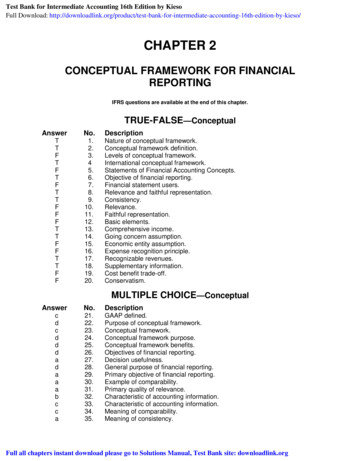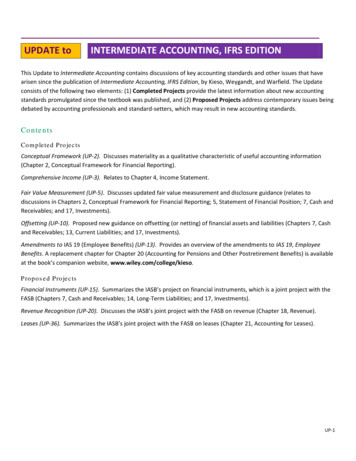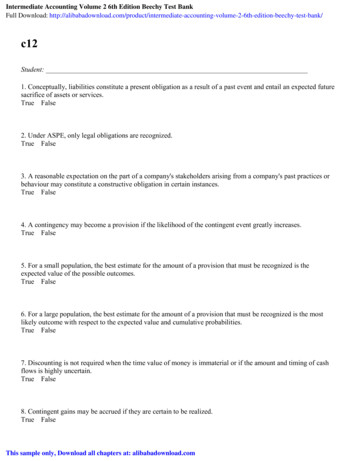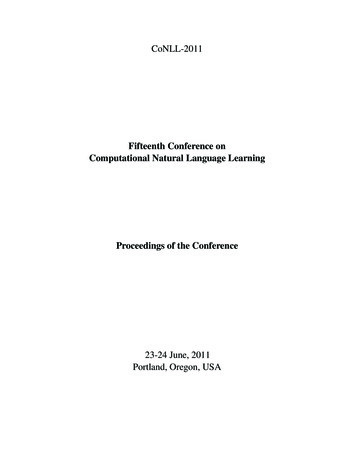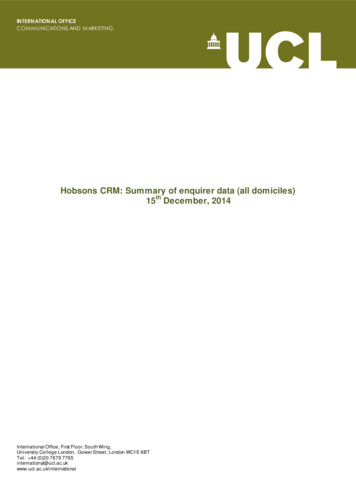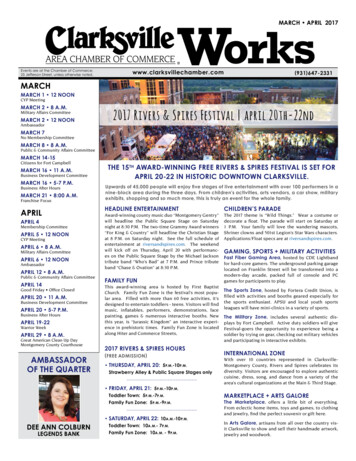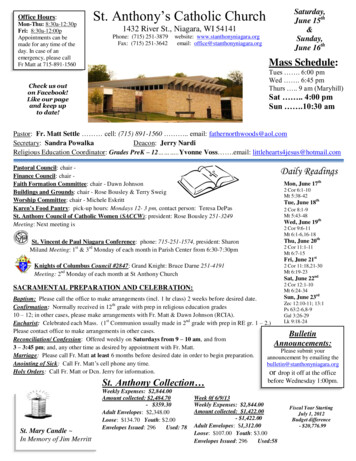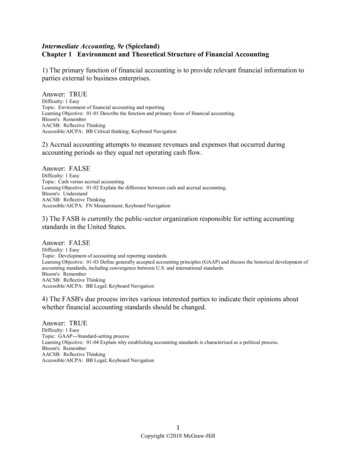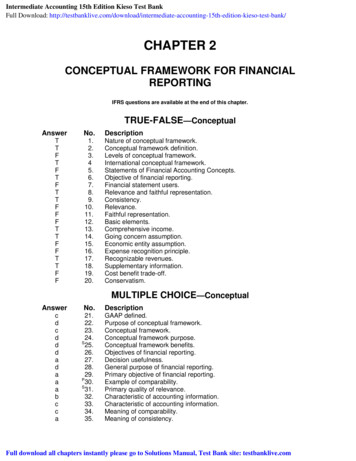
Transcription
Intermediate Accounting 15th Edition Kieso Test BankFull Download: unting-15th-edition-kieso-test-bank/CHAPTER 2CONCEPTUAL FRAMEWORK FOR FINANCIALREPORTINGIFRS questions are available at the end of this 14.15.16.17.18.19.20.Nature of conceptual framework.Conceptual framework definition.Levels of conceptual framework.International conceptual framework.Statements of Financial Accounting Concepts.Objective of financial reporting.Financial statement users.Relevance and faithful representation.Consistency.Relevance.Faithful representation.Basic elements.Comprehensive income.Going concern assumption.Economic entity assumption.Expense recognition principle.Recognizable revenues.Supplementary information.Cost benefit trade-off.Conservatism.MULTIPLE onGAAP defined.Purpose of conceptual framework.Conceptual framework.Conceptual framework purpose.Conceptual framework benefits.Objectives of financial reporting.Decision usefulness.General purpose of financial reporting.Primary objective of financial reporting.Example of comparability.Primary quality of relevance.Characteristic of accounting information.Characteristic of accounting information.Meaning of comparability.Meaning of consistency.Full download all chapters instantly please go to Solutions Manual, Test Bank site: testbanklive.com
2-2Test Bank for Intermediate Accounting, Fifteenth EditionMULTIPLE 76.77.78.79.80.81.82.83.84.DescriptionIngredient of relevance.Ingredient of reliability.Consistency characteristic.Primary quality of accounting information.Quality of relevance.Quality of reliability.Consistency quality.Decision-usefulness criterion.Primary qualities of accounting information.Definition of relevance.Definition of reliability.Relevance quality.Materiality characteristic.Completeness characteristic.Neutrality characteristic.Neutrality characteristic.Definition of verifiability.Quality of predictive value.Quality of free from error.Consistency.Consistency characteristic.Comparability and consistency.Comparability.Elements of financial statements.Distinction between revenues and gains.Definition of a loss.Definition of comprehensive income.Components of comprehensive income.Comprehensive income.Earnings vs. comprehensive income.Reporting financial statement elements.Basic element of financial statements.Basic element of financial statements.Basic element of financial statements.Definition of gains.Historical cost assumption.Periodicity assumption.Going concern assumption.Periodicity assumption.Monetary unit assumption.Periodicity assumption.Monetary unit assumption.Economic entity assumption.Economic entity assumption.Periodicity assumption.Going concern assumption.Going concern assumption.Implications of going concern assumption.Historical cost principle.(cont.)
Conceptual Framework Underlying Financial AccountingMULTIPLE .122.123.P124.(cont.)DescriptionHistorical cost principle.Revenue recognition principle.Revenue recognition principle.Revenue recognition principle.Measurement principle.Expense recognition principle.Product costs.Expense recognition principle.Expense recognition principle.Expense recognition.Full-disclosure principle.Argument against historical cost.Recognition of revenue.Revenue recognition principle.Definition of performance obligation.Required components of financial statements.Recognition of expenses.Historical cost principle.Expense recognition principle example.Recording expenditure as asset.Historical cost principle violation.Full disclosure principle violation.Full disclosure principle.Historical cost principle violation.Industry practice constraint.Costs of providing financial information.Benefits of providing financial information.Use of materiality.Definition of prudence/conservation.Example of materiality constraint.Constraints to limit the cost of reporting.Cost-benefit relationship.Materiality characteristic.Materiality.Pervasive constraints.Prudence or conservatism.Conceptual framework second levelTrade-offs between characteristics of accounting information.Trade-offs between characteristics of accounting information.Prudence or conservatism.2-3
2-4Test Bank for Intermediate Accounting, Fifteenth EditionMULTIPLE CHOICE—CPA .131.132.133.DescriptionQuality of predictive value.Relevance and faithful representation.Classification of gains and losses.Earnings concept.Components of comprehensive income.Components of comprehensive income.Components of comprehensive income.Components of comprehensive income.Definition of recognition.Note: these questions also appear in the Problem-Solving Survival Guide.Note: these questions also appear in the Study Guide.BRIEF tative characteristics.Accounting concepts—identification.Accounting 139E2-140E2-141Accounting concepts—matching.Accounting concepts—fill in the blanks.Basic assumptions.Historical cost principle.Matching concept.CHAPTER LEARNING OBJECTIVES1. Describe the usefulness of a conceptual framework.2. Describe the FASB’s efforts to construct a conceptual framework.3. Understand the objective of financial reporting.4. Identify the qualitative characteristics of accounting information.5. Define the basic elements of financial statements.6. Describe the basic assumptions of accounting.7. Explain the application of the basic principles of accounting.
Conceptual Framework Underlying Financial Accounting8. Describe the impact that the cost constraint has on reporting accounting information.9. Compare the conceptual frameworks underlying GAAP and IFRS.2-5
2-6Test Bank for Intermediate Accounting, Fifteenth EditionSUMMARY OF LEARNING OBJECTIVES BY 7.TypeItemTypeItemLearning Objective 1SMC25. MCMC134.ELearning Objective 2TF26. MC94.Learning Objective 3MCBELearning Objective 4MC44. MC50.MC45. MC51.MC46. MC52.MC47. MC53.MC48. MC54.MC49. MC55.Learning Objective 5SMC66. MC69.MC67. MC70.MC68. MC127.Learning Objective 6MC78. MC81.MC79. MC82.MC80. MC83.Learning Objective 7MC99. MC105.MC100. MC106.MC101. MC107.MC102. MC108.MC103. MC133.MC104. MC135.Learning Objective 8MC116. MC119.MC117. MC120.MC118. ng Objective 9 – IFRS Questions3. TF4. TF5. TF10. TF11. MC12. MC17. SATF True-FalseSA Short AnswerMC Multiple Choice BE Brief ExercisesE Exercise
Conceptual Framework Underlying Financial Accounting2-7TRUE-FALSE—Conceptual1. A soundly developed conceptual framework enables the FASB to issue more useful andconsistent pronouncements over time.2. A conceptual framework is a coherent system of concepts that flow from an objective.3. The first level of the conceptual framework identifies the recognition, measurement, anddisclosure concepts used in establishing accounting standards.4. The IASB has issued a conceptual framework and has agreed to develop a commonconceptual framework with the FASB.5. Although the FASB has developed a conceptual framework, no Statements of FinancialAccounting Concepts have been issued to date.6. The objective of financial reporting is the foundation of the conceptual framework.7. Users of financial statements are assumed to need no knowledge of business and financialaccounting matters to understand information contained in financial statements.8. Relevance and faithful representation are the two primary qualities that make accountinginformation useful for decision making.9. The idea of consistency does not mean that companies cannot switch from one accountingmethod to another.10. Timeliness and neutrality are two ingredients of relevance.11. Verifiability and predictive value are two ingredients of faithful representation.12. Revenues, gains, and distributions to owners all increase equity.13. Comprehensive income includes all changes in equity during a period except thoseresulting from investments by owners and distributions to owners.14. The historical cost principle would be of limited usefulness if not for the going concernassumption.15. The economic entity assumption means that economic activity can be identified with aparticular legal entity.16. The expense recognition principle states that debits must equal credits in each transaction.17. Revenues are recognized in the accounting period in which the performance obligation issatisfied.18. Supplementary information may include details or amounts that present a differentperspective from that adopted in the financial statements.
2-8Test Bank for Intermediate Accounting, Fifteenth Edition19. In order to justify requiring a particular measurement or disclosure, the benefits to bederived from it must equal the costs associated with it.20. Prudence or conservatism means when in doubt, choose the solution that will be least likelyto overstate liabilities or expenses.True False 6.17.18.19.20.Ans.FTTFFMULTIPLE CHOICE—Conceptual21.Generally accepted accounting principlesa. are fundamental truths or axioms that can be derived from laws of nature.b. derive their authority from legal court proceedings.c. derive their credibility and authority from general recognition and acceptance by theaccounting profession.d. have been specified in detail in the FASB conceptual framework.22.A soundly developed conceptual framework of concepts and objectives shoulda. increase financial statement users' understanding of and confidence in financialreporting.b. enhance comparability among companies' financial statements.c. allow new and emerging practical problems to be more quickly solved.d. All of these answer choices are correct.23.Which of the following is not true concerning a conceptual framework in accounting?a. It should be a basis for standard-setting.b. It should allow practical problems to be solved more quickly by reference to it.c. It should be based on fundamental truths that are derived from the laws of nature.d. All of these answer choices are true.24.What is a purpose of having a conceptual framework?a. To enable the profession to more quickly solve emerging practical problems.b. To provide a foundation from which to build more useful standards.c. Neither a nor b.d. To enable the profession to more quickly solve emerging practical problems and toprovide a foundation from which to build more useful standards.
Conceptual Framework Underlying Financial AccountingSP2-925.Which of the following is not a benefit associated with the FASB Conceptual FrameworkProject?a. A conceptual framework should increase financial statement users' understanding ofand confidence in financial reporting.b. Practical problems should be more quickly solvable by reference to an existingconceptual framework.c. A coherent set of accounting standards and rules should result.d. Business entities will need far less assistance from accountants because the financialreporting process will be quite easy to apply.26.In the conceptual framework for financial reporting, what provides "the why"--the purposeof accounting?a. Recognition, measurement, and disclosure concepts such as assumptions, principles,and constraintsb. Qualitative characteristics of accounting informationc. Elements of financial statementsd. Objective of financial reporting27.The underlying theme of the conceptual framework isa. decision usefulness.b. understandability.c. faithful representation.d. comparability.28.The objective of general-purpose financial reporting is to provide financial informationabout a reporting entity to each of the following excepta. potential equity investors.b. potential lenders.c. present investors.d. All of these answers are correct.29.What is the primary objective of financial reporting as indicated in the conceptualframework?a. Provide information that is useful to those making investing and credit decisions.b. Provide information that is useful to management.c. Provide information about those investing in the entity.d. All of these answer choices are correct.30.If the LIFO inventory method was used last period, it should be used for the current andfollowing periods because ofa. comparability.b. materiality.c. timeliness.d. verifiability.
2 - 10STest Bank for Intermediate Accounting, Fifteenth Edition31.What is the following is a characteristic describing the primary quality of relevance?a. Predictive value.b. Materiality.c. Verifiability.d. Understandability.32.Which of the following is a fundamental quality of useful accounting information?a. Comparability.b. Relevance.c. Neutrality.d. Materiality.33.Which of the following is a primary quality of useful accounting information?a. Conservatism.b. Comparability.c. Faithful representation
Test Bank for Intermediate Accounting, Fifteenth Edition 2 - 8 19. In order to justify requiring a particular measurement or disclosure, the benefits to be derived from it must equal the costs associated with it. 20. Prudence or conservatism means when in doubt, choose the solution that will be least likely to overstate liabilities or expenses. True False Answers—Conceptual Item Ans. Item .
